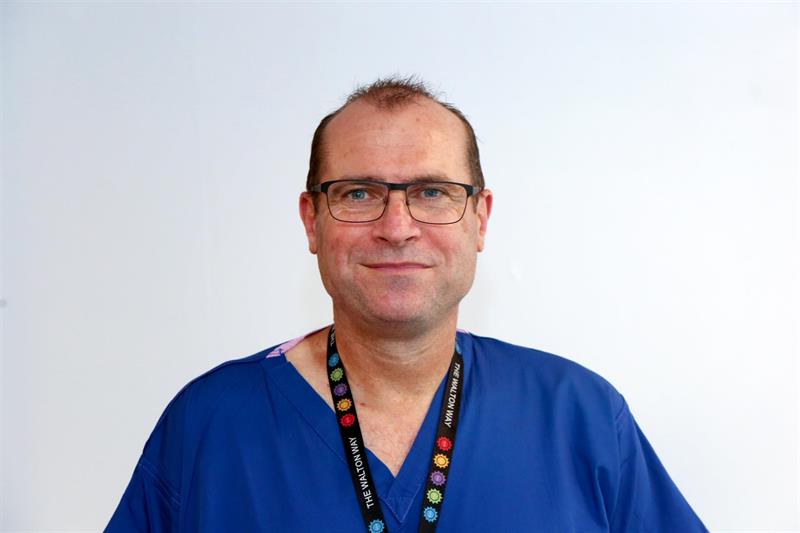Professor Andrew Brodbelt
About Andrew Brodbelt

Professor Andrew Brodbelt graduated from Liverpool Medical School before doing his basic surgical training in Merseyside and Manchester, and neurosurgical training at The Walton Centre. He did his PhD at the University of New South Wales, Sydney, Australia.
In 2005 he was appointed Consultant Neurosurgeon and lead for Neurosurgical Oncology at The Walton Centre. Since then he has been involved in local, regional and national programmes of care in oncology including NCIN (then NCRAS), NCRI brain tumour group, National Brain Tumour Clinical reference group, and then SRS Expert Reference Group. He was previously the Merseyside and Cheshire Clinical Network Group Chair. As a clinical manager he was the Neurosurgical Clinical Director, then divisional clinical director before stepping down in December 2020. He is also an Honorary Clinical Senior Lecturer at The University of Liverpool.
His clinical work focuses on brain tumour patient care, and in patients with Chiari and Syringomyelia, with care of vascular, hydrocephalus, trauma, and degenerative spinal patients. He runs specialist brain tumour, vascular, and syringomyelia/Chiari clinics.
His research work has been mainly in oncology epidemiology and the pathophysiology of syringomyelia. He is the named author on 75 peer reviewed papers and six book chapters. Recent research publications include:
- The outcome of patients with surgically treated meningioma in England: 1999-2013. A cancer registry data analysis. Brodbelt AR, Barclay ME, Greenberg D, Williams M, Jenkinson MD, Karabatsou K Br J Neurosurg. 2019 Dec;33(6):641-647.
- Brain Metastases? Brodbelt AR and Zakaria R in Oxford Textbook of Neurological Surgery Ed Kirollos R, Helmy A, Thomson S, and Hutchinson P.? Oxford University Press 2019
- Glioblastoma in England: 2007-2011 Brodbelt A, Greenberg D, Winters T, Williams M, Vernon S, Collins VP; (UK) National Cancer Information Network Brain Tumour Group. Eur J Cancer. 2015 Mar;51(4):533-542.
- CSF pathways: a review.? Brodbelt A, Stoodley M. Br J Neurosurg. 2007 Oct;21(5):510-20.
- Fluid flow in an animal model of post-traumatic syringomyelia. Brodbelt AR, Stoodley MA, Watling AM, Tu J, Jones NR. Eur Spine J. 2003 Jun;12(3):300-6
Speciality
Neurosurgery
Qualifications
BSc(HONS), MBChB, FRCSEd(Neuro.Surg), PhD
Clinical/research interests
Clinical interests
Neuro-oncology
SRS
Chiari and Syringomyelia
Hydrocephalus
Vascular disease
Degenerative spinal disease.
Research Interests
Oncology: Epidemiology of brain tumours, long term survivors of Glioblastoma, tumour treating fields
Chiari / syringomyelia: Pathophysiology, CSF dynamics, treatment outcomes, and the role of surgery in patients with EDS.
Membership of professional regional and national bodies
Chair, Merseyside and Cheshire Clinical Quality Group for Brain and CNS tumours
Treasurer, British Neurooncology Society
Member of Brain Tumour North West
Member, Society of British Neurological Surgeons
Related Services
Neurosurgery
The Neurosurgical Division is one of the busiest neurosurgical units in the UK, seeing approximately 9,800 new patients, 3,800 elective patients, and 1,700 emergency inpatients every year.
Neuro-Oncology Department
The Walton Centre Neuro-Oncology team provide a dedicated surgical oncology service for patients diagnosed with brain and central nervous system tumours.
Chiari malformation and syringomyelia
Chiari (previously called an Arnold-Chiari malformation) malformation is an abnormality of the posterior fossa (back of the skull) and top of the spine. There are different types.
Page last updated: 14 July 2021
118